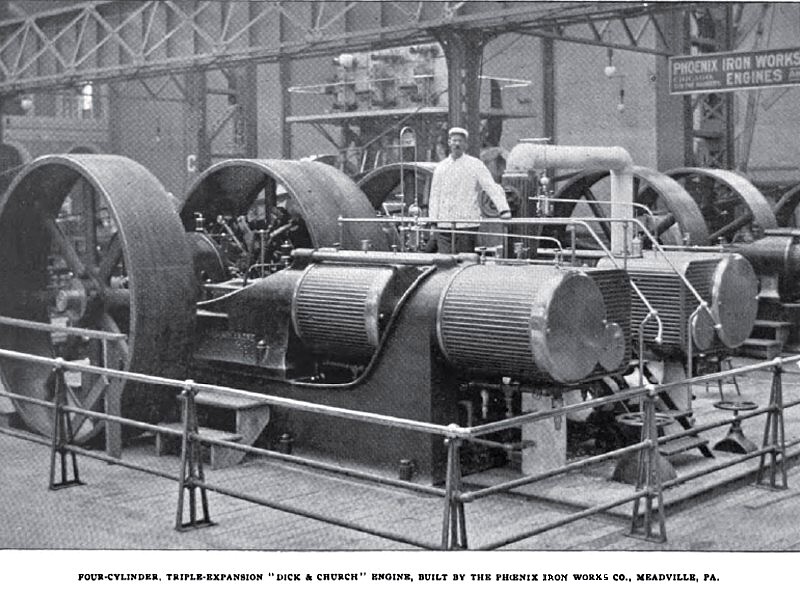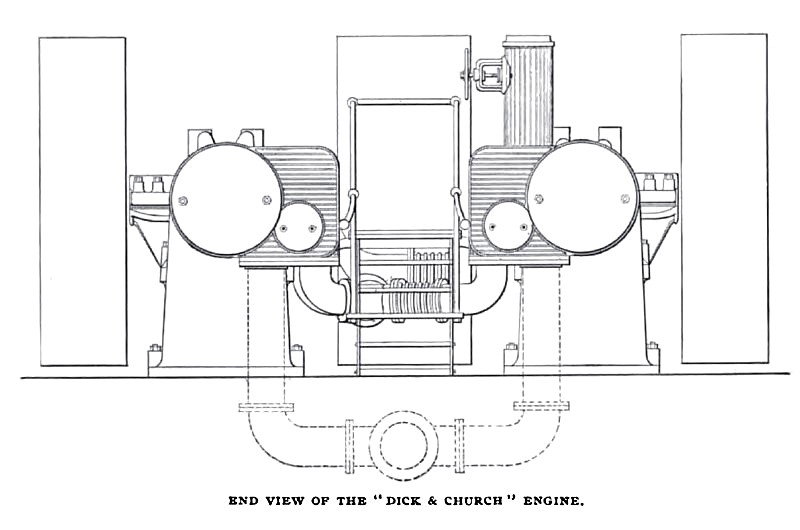|
Title: |
1893 Article-Phœnix Iron Works Co., Dick & Church Triple Expansion Steam Engine |
|
Source: |
Cassier's Magazine Sep 1893, pgs. 334 & 335 |
|
Insert Date: |
11/28/2012 9:10:12 PM |
|
One of the most attractive and novel engines on exhibition is the "Dick & Church " four-cylinder triple-expansion engine of the double tandem, cross-compound type, built by the Phœnix Iron Works Company, of Meadville, Pa. This engine is substantially a combination of two of their tandem-compound engines, illustrated in the May number of this magazine, and the description, which was there given applies largely to the general features of each side of the present design, with the exception that on one side the intermediate cylinder is substituted for the high-pressure cylinder of the regular tandem engine, being secured to the small, or high-pressure bed. The two low-pressure cylinders are placed in the rear, each being carried on a sub-bed. Each side of the engine has substantially the same valve gear as the regular tandem compound engine, and the governor is also substantially the same. This valve gear is placed on the inside. The governor is made double and is placed in the intermediate wheel. It is so cross-connected that the two sides of the engine are compelled to act together, the one governor controlling the valves of all four cylinders, thus insuring close regulation and the proper distribution of load, temperatures and initial thrusts throughout the whole range from friction load to full load. The steam passes from the high-pressure cylinder to the intermediate cylinder on the opposite side, and from this cylinder it is carried by a branched pipe to both of the low- pressure cylinders. These intermediate pipes are connected with the under side of each steam chest, and are kept as high as practicable to prevent the formation of dangerous water traps between cylinders. A neat platform, with steps at the rear, is placed between the engines and over the intermediate pipes. This gives ready and convenient access to the valve gear, cross-head and guides, throttle valve and other parts, and two oil cups, one on each front corner post of the platform railing with pipes leading to all the parts requiring lubrication, including the eccentrics and the pins and bearings of the governor, enable the engineer to keep all working parts thoroughly lubricated while the engine is in motion. The observer cannot fail to note that the cross-connected intermediate pipes, which in most cross-connected engines are such a disfigurement, as well as an obstruction, are entirely hidden by the platform. The cylinders, steam chests, cylinder heads and intermediate pipes have non-conducting coverings, with metal outside lagging. The two sides of the engine are placed close together, but at the same time ample space is provided for all the parts and easy access to all of them. That the engine is compactly built is evident from the fact that, although rated at 525 horse-power, with a maximum capacity of 750 horse-power, it only occupies a floor space of 17 feet 8 inches in width, by 27 feet 7 inches in length, measured clear of the wheels. The high-pressure cylinder is 15 inches in diameter; the intermediate, 24 inches, and the two low-pressure cylinders each measure 26 inches, while the stroke of all is 18 inches. The wheels are 108 inches in diameter, the two outside ones having 26-inch faces, while the centre one has a 38-inch face. The working speed is 200 revolutions per minute. The engine presents a graceful appearance, at the same time impressing the observer with a sense of its massiveness and the great amount of power stored in such compact space, coupled with extreme simplicity of construction. |
|
 1893 Phœnix Iron Works Co., Dick & Church Triple Expansion Steam Engine
1893 Phœnix Iron Works Co., Dick & Church Triple Expansion Steam Engine
 1893 Phœnix Iron Works Co., Dick & Church Triple Expansion Steam Engine (End View)
1893 Phœnix Iron Works Co., Dick & Church Triple Expansion Steam Engine (End View)
|
|